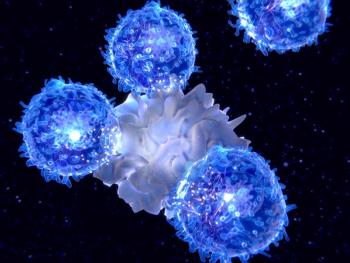
Oncology NEWS International
- Oncology NEWS International Vol 10 No 2
- Volume 10
- Issue 2
Chemoimmunotherapy Nudges Failure-Free Survival Upward in Advanced Follicular NHL
HOUSTON-Chemoimmunotherapy with rituximab (Rituxan) plus fludarabine, novantrone (mitoxantrone), and dexamethasone (FND) reduced levels of a major tumor marker and significantly improved projected 2-year failure-free survival in patients with stage IV indolent follicular non-Hodgkin’s lymphomas (NHL) who had molecular responses after 6 months of treatment. Results from a randomized study of 134 previously untreated patients were presented by Fernando F. Cabanillas, MD, chairman of the Department of Lymphoma-Myeloma at the University of Texas M. D. Anderson Cancer Center in Houston.
HOUSTON-Chemoimmunotherapy with rituximab (Rituxan) plus fludarabine, novantrone (mitoxantrone), and dexamethasone (FND) reduced levels of a major tumor marker and significantly improved projected 2-year failure-free survival in patients with stage IV indolent follicular non-Hodgkin’s lymphomas (NHL) who had molecular responses after 6 months of treatment. Results from a randomized study of 134 previously untreated patients were presented by Fernando F. Cabanillas, MD, chairman of the Department of Lymphoma-Myeloma at the University of Texas M. D. Anderson Cancer Center in Houston.
"We found a significantly higher molecular response rate [reduction in the number of cells exhibiting bcl-2 gene rearrangement] in peripheral blood and in bone marrow at 6 months in patients treated with simultaneous rituximab plus FND (R-FND), but at 12 and 18 months, molecular responses were equivalent for both arms," Dr. Cabanillas said. "Projected failure-free survival [FFS] at 24 months is 92% for patients with molecular responses in their peripheral blood at 6 months vs 48% for patients without such molecular responses (P = .01)."
Dr. Cabanillas said that although stage IV indolent lymphomas are currently considered incurable, the achievement of an early molecular remission, as determined by the bcl-2 polymerase chain reaction, or PCR assay, is associated with a better outcome. "In view of its excellent correlation with failure-free survival, the PCR technique has the potential of providing a tumor marker that can be used as an early surrogate endpoint. In search for a treatment which could result in a higher molecular response rate, we designed a study that combines eight courses of FND with the monoclonal antibody rituximab," he said.
Patients were randomized to either concurrent R-FND (rituximab given on day 1 of the first six FND courses) or to delayed FND-R (FND first, followed by rituximab × 6 starting 12 months later). All patients also received interferon for 1 year. "We randomized between the potentially synergistic concurrent antibody/chemo combo vs delayed administration of antibody, which takes advantage of the recovery of immune function at the time of rituximab administration," Dr. Cabanillas said.
Gene Rearrangements
Baseline PCR data, available on 107 of the patients, showed that 77 of 107 (73%) had bcl-2 rearrangement in the peripheral blood and that 72/107 (67%) had such gene rearrangements in the bone marrow. Median follow-up was 12 months. Follow-up PCR data available at the time of this report included peripheral blood analysis for 54 patients after 6 months of treatment, 18 patients after 12 months, and 15 patients after 18 months. PCR data on bone marrow included 40 patients after 6 months of treatment, 22 after 12 months, and 12 after 18 months.
Although the 6-month data showed significantly better molecular responses in patients treated with simultaneous R-FND, this difference vanished by 12 months. "At this point there is no significant difference in FFS between the two arms of the study, although the trend favors the concurrent arm," Dr. Cabanillas said.
In addition, the relationship between 6-month molecular response and clinical complete response is complex. Dr. Cabanillas said that although the 6-month peripheral blood molecular response rate was higher for clinical complete responders, 18% of clinical complete responders did not show molecular responses, and 50% of patients who had only partial clinical responses did have molecular responses.
Articles in this issue
almost 25 years ago
Activated T Cells Can Alter Behavior of Leukemic B Cellsalmost 25 years ago
Response Continues for at Least 8 Months with Ibritumomab Tiuxetanalmost 25 years ago
Synthetic Anthracycline Produces High Response Rates in SCLCalmost 25 years ago
Ibritumomab Tiuxetan Produces 73% Response Rate in B-cell NHLalmost 25 years ago
G-CSF Might Prolong Rituximab Responses in NHLalmost 25 years ago
Use of CAD Increases the Early Detection of Breast Cancer by 20%almost 25 years ago
Rituximab Plus Fludarabine May Be Good Alternative to Rituximab Plus CHOPNewsletter
Stay up to date on recent advances in the multidisciplinary approach to cancer.

















































































